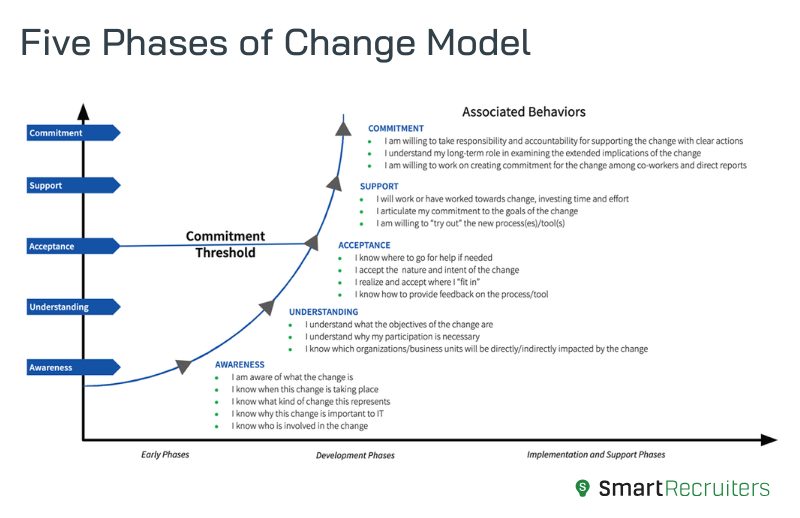Keeping stakeholders aligned during a talent acquisition transformation requires ongoing care and attention. Change management isn’t necessarily about making everyone on your team happy all the time, but rather ensuring their expectations are aligned and that they know how to make a positive contribution.
This post offers keys to change management excerpted from the newly updated Definitive Guide to Hiring Success. The guide takes readers on a step-by-step journey to creating a world-class TA function that attracts, engages, and retains the best talent.
Change Doesn’t Happen All at Once
Changing people’s behavior is a continuous process, not a one-time event. Engagement with the audience is needed through the different stages of the project and gaining acceptance and engagement along the way helps get the required commitment to the transformation.
The Five Phases of Change model can help team leaders navigate this journey. Understanding the phases can help leaders tailor the messaging and manage the expectations of audiences. Leaders need to be patient and not expect too much from the other stakeholders too soon.
Provide them the opportunity to move through the five phases of change outlined below. For each phase, you can see the associated behaviors of your audience in the form of how they speak regarding the project. You can use this to identify in which phase your audience currently sits.

5 Phases of Change in TA Transformation
1. Awareness
The first phase is centered on introducing plans and the project to the audience for the first time. At this point, communication needs to be frequent and at a high level. The priority is putting forward the reasons for the change, why it’s important, how long it will take, and which parties are involved. The aim here is to put the transformation project on the radar of as many people as possible.
2. Understanding
Once the initial foundations have been laid, the objective can turn to connecting the project to the individuals and making sure they understand the objectives, why their participation is required, and what parts of the organization will be affected.
3. Acceptance
At this point, the messaging changes tone slightly as the priority now shifts to getting all stakeholders to understand the project on their own terms and what they need to bring to the working group. Make your communications small and frequent by providing easily digestible information in short bites.
Taking a personalized approach ensures that each audience member understands the nature of the change required and how they will personally help bring it about. Within this phase, it’s also useful to define communication avenues that allow stakeholders to feel like they have opportunities to voice their concerns.
4. Support
Within the support phase, the aim is to encourage people to change their perspective on the project and to feel like they own it too. Initially, people won’t attach themselves to the project personally. However, once you move through this phase people will start to refer to it as “their project” or state that they are part of the project. These are clear signs that they have begun to associate themselves with it and embrace it fully.
5. Commitment
The next phase is commitment, where people fully embrace the change and take ownership of their role in it. They are fully invested in the project and are willing to put in the necessary effort to see it through. This is the stage where leaders can expect to see high levels of productivity and engagement from the team.
It’s important to remember that not everyone will reach this stage at the same time, and that some may need additional support and guidance along the way. Keep open communication lines, provide the necessary resources and support, and be understanding of the challenges people may face as they navigate through the change.
If deadlines and deliverables are pushed prematurely before people have passed the commitment threshold, there is a chance they will resist or disengage from the project.
In the final phase of commitment, stakeholders fully embrace their role and responsibility in the project. Communication focuses on deliverables and achieving goals. Indicators of full commitment include taking the initiative to convince others and motivating other members of the team. This shift in responsibility allows for a more effective and sustainable change process as people start to drive the change like it is their own.
4 Tips for Dealing with Change Management
Change management can be a sensitive area to navigate but there are some best practice tips and tricks that leaders can use to make things a little easier especially when delivering communications to individuals or teams.
1. Adapt the content if the message isn’t landing correctly
Audiences are hard to manage and a project team is no different. If the messages being shared aren’t landing well, it’s possible that the message is being conveyed at a level the project team is not ready for. If this occurs, try to go one or more phases back so that you can connect with the audience.
2. If people fall back a phase, don’t be discouraged, just adapt the messaging
Where people sit on the change management model can fluctuate. When the project hits a crucial period, people may fall back out of fear or confidence. In scenarios like this, move back to a previous communication layer and try reconnecting first before moving up to the next phase again. Leaders need to remember to be sensitive to the needs of their team when moving fast. When engagement drops, focus on the fundamentals of the project and why it’s important, and then move forward again.
3. People flow through the five phases but you don’t need separate communications
While we know that people need to move from one phase to the next, this does not mean you have to communicate with people at all layers of the model. What’s important is building the story in the right order so the narrative follows the five levels.
4. Everyone won’t get to the end
Not everyone will make it to the commitment level, and they don’t need to. People can work very effectively in the acceptance and support phase. Change leaders look for one change champion in each initiative. These individuals will naturally start to carry the weight of keeping everybody onboard and focused on delivery.
The key to developing champions is through effective delegation. Letting go in certain areas gives the change champions the responsibility to take the lead in their own individual areas.
Change Management is More Important Than Ever
As technology advances, people are confronted with more and more change at once. Keeping everyone on board with change helps TA teams get the most out of their technology investments. By ensuring the adoption of new processes and technology, companies reap the benefits of better data integrity, improved candidate experiences, better hiring team engagement, and eventually, better quality of hire. Read our story from Colliers EMEA on how they managed a transformation to net a 25% improvement in new hire retention.
The Definitive Guide to Hiring Success offers a detailed look into the Hiring Success framework. By understanding the framework, your TA team will be able to develop a roadmap for an effective transformation. Download the guide today to get practical tools and strategies to make your change a success.







